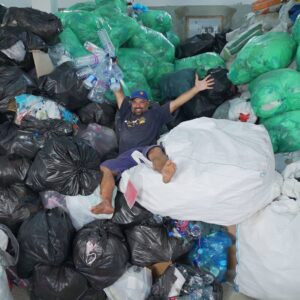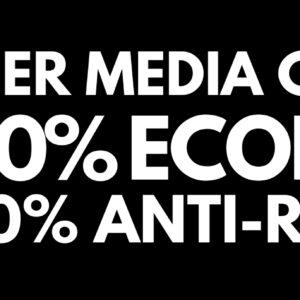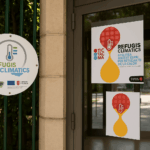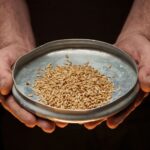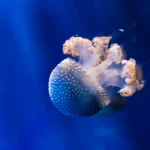Off the Tunisian coast, coexistence between fishermen and dolphins is far from idyllic. Every day, these adorable mammals are targeted, accused of ravaging nets and taking a large share of the fish catch. But the truth is far more complex than that.
Dolphins are not the only culprits behind the damage caused to fishing nets. Rather, their intrusion into these aquatic traps is a sad consequence of the drastic decline in fish stocks in Tunisian waters. Over the last few decades, these stocks have been decimated by up to 60%, leaving the dolphins hungry and searching for food.
Unfortunately, this desperate quest for food has led to competition between dolphins and fishermen for the same fishery resources, creating an ongoing conflict. The fishermen, eager to protect their nets and their catch, will stop at nothing to eliminate the dolphins, even going so far as to inflict a cruel death on them.
Ghar EL Melh, February, 2023
The dolphin: a gentle beauty in danger from irresponsible fishing practices
Dolphins have a similar diet to humans, feeding mainly on pelagic fish, cephalopods and crustaceans. However, this dietary similarity has led to conflicts with fishermen, who blame them for the decline in fish stocks and the economic damage caused to their fishing gear. Unfortunately, under the pretext of these accusations, the consequence is often the gruesome killing of dolphins.
In some parts of Tunisia, fishermen slaughter dolphins or cut off their tail fins, leaving them unable to swim, according to some fishermen. When a dolphin is seriously injured, it alerts its pod by emitting sound waves at specific frequencies to inform its fellow dolphins to disperse from the area at risk. Despite the handicap of an amputated flipper, the animal uses alternative modes of communication to interact with other members of its group.
The dolphin is incredibly intelligent! After being returned to the water without flippers, condemned to a slow death, the dolphin strikes the surface of the water with its tail to disperse the rest of the herd, especially when newborns are present.
Explains Mehdi Aissi, cetologist and head of the marine program at the World Wildlife Fund (WWF) Tunisia.
Fishermen know no bounds when it comes to indulging their animosity towards dolphins, going so far as to invent methods of unimaginable cruelty towards these animals. To preserve the anonymity of our interviewee, we’ll call him Houssem*. Houssem* told us of acts committed by fishermen in Libya that are unbelievably cruel: fishermen stuff fish with dynamite and then throw them to the dolphins, causing them to explode. A ferocity unequalled on our planet!
This criminal practice is not only appalling, but also reprehensible, as it does nothing to resolve the underlying causes of the conflict between dolphins and fishermen. Indeed, rather than seeking sustainable solutions, fishermen continue to commit inhumane acts against these innocent marine creatures. In so doing, they demonstrate their lack of concern for ecological balance and the protection of marine life.
Dolphins are frequently eliminated from their natural habitat. It’s important to realize that we are invading the dolphins’ natural environment, not the other way around!
Mehdi Aissi
The reasons behind this strained relationship
Fishermen only see dolphins as adversaries when they come face to face at sea. Rather than blaming them, it is essential to understand objectively the reasons for this situation.
Unfortunately, according to Mehdi Aissi, overexploitation of fishery resources, often overlooked, is the main reason for negative interaction with dolphins.
The number of fishing boats, both artisanal and industrial, is constantly increasing. Fishing limits are often no longer respected. In addition, catches of reproductive species out of season have also contributed to an alarming decline in marine biological stocks. According to Mehdi Aissi, this decline has reached almost 60% since the 1990s, according to statistical models.
In addition to overfishing, pollution and global warming also have an impact on fish populations, which often migrate to cooler or deeper waters to survive environmental changes. This leaves coastal waters less populated, which can drive dolphins to seek out new food sources.
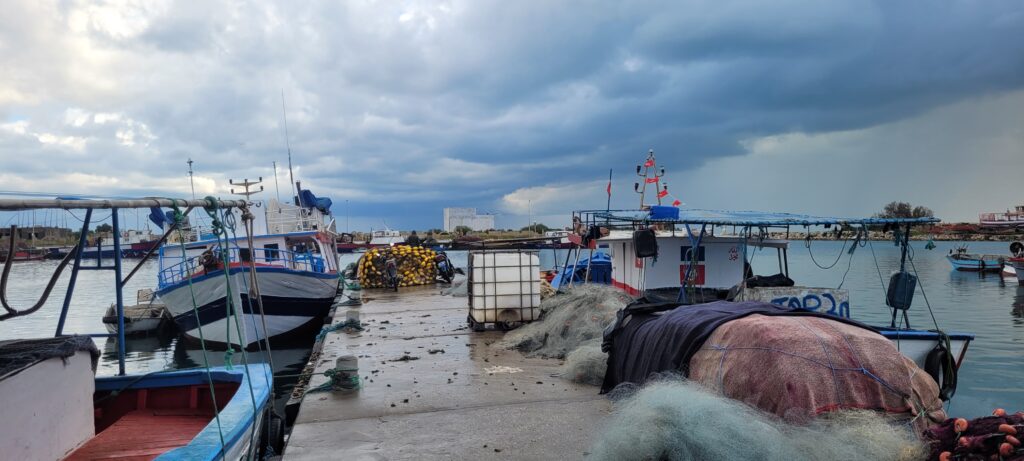
It is precisely this situation that has led dolphins to turn to fishing nets for food, a more energy-efficient alternative to hunting. This highlights the importance of being aware of the impact of our activities on the marine ecosystem, and the need to implement measures to preserve marine life.
The dolphin: a GPS for fishing nets
The dolphin is recognized as one of the friendliest animals on the planet, thanks to its inquisitive and sociable nature, which brings it close to the human species. Endowed with remarkable intelligence, they fascinate scientists and fishermen alike, who observe their behavior with wonder.
Its extraordinary ability to spot fishing nets and feed on their prey is one of its most striking features.
This animal has adapted brilliantly to our fishing techniques, acquiring an unfailing understanding of our activity. As soon as it hears the sound of boats or nets, it instantly understands where its prey is. And what’s even more astonishing is its precision: it can locate nets with frightening accuracy as soon as they are deployed, as if it had a built-in GPS system! Enough to make the best hunters green with envy.
Mehdi, fisherman in Ghar el Melh
Thanks to scientific research, we have a better understanding of how these animals achieve this feat. The echolocation technique used by dolphins is the key to their ability to accurately locate any surrounding obstacle, in real time and even in the dark. This method of vision uses their natural sonar, located in their skull. It is made up of small sacs that fill with air when dolphins breathe. The sound waves thus produced are emitted in a wide radius and reflected when they encounter an obstacle. The echo is channeled by the dolphin’s jaw to its inner ear, which is in direct contact with the brain. The brain processes this image of the obstacle as an X-ray image, enabling the dolphin to map their environment.
Not surprisingly, this ability in dolphins is unrivalled in the animal kingdom. In fact, they are able to detect even objects as small as a golf ball from a distance of over 50 meters, in just a few milliseconds.
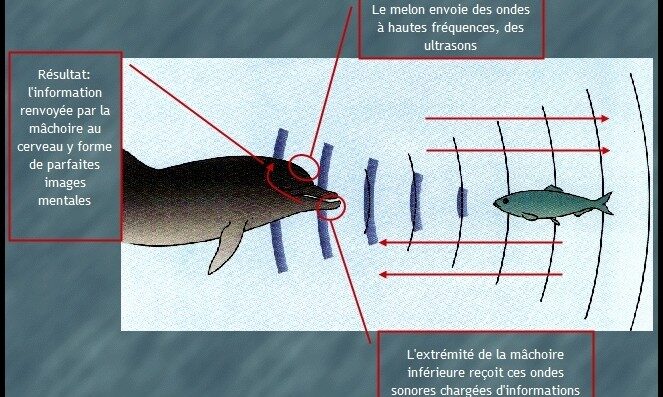
In the Tunisian sea, fishermen regularly come up against a major competitor from the delphinid family: the Bottlenose dolphin (Tursiops truncatus), the dolphin species most frequently observed in the region. This impressive mammal can weigh between 150 and 500 kilos and consume up to 8 kilos of food a day1, making it a voracious and competitive consumer.
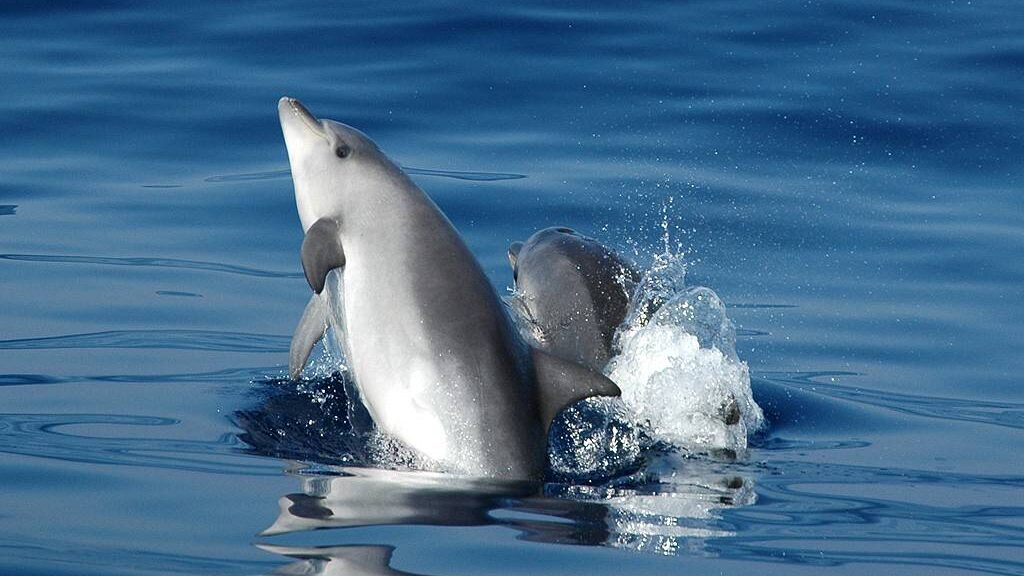
Conflicts between dolphins and fishermen are not new to the Tunisian Sea. Indeed, dolphins are known to have a great capacity to adapt to their environment, which enables them to adapt to changes in food availability and to approach fishing zones to find their prey.

This finding is confirmed by a study carried out in June 2018 in the small pelagic fisheries of Kélibia. Cetology expert Rimel Benmessaoud reveals that dolphin attacks on schools of fish concentrated under the lights result in a total loss of catch. While dolphin attacks on schools of fish encircled by purse seines damage fishing nets. They partially reduce the catch. And they create economic losses. The frequency of dolphin attacks during fishing trips is around 30 to 43%. But it varies according to the environment and the mammal’s behavior. These attacks account for 7% of the downtime spent repairing nets, with an estimated 77% of tears caused by dolphins.
Mehdi Aissi reports that dolphins and fishermen have been interacting regularly for several years. This collaborative fishing phenomenon has been particularly observed in the Brazilian town of Laguna. The dolphins guide the fish towards the coast, making it easier for the fishermen to catch them. This collaboration is beneficial for both parties: the fishermen get bigger catches, and the marine mammals feed on the fish that try to escape.
Between protecting dolphins and the economic viability of local fishing
In the past, fishermen in Ghar El Melh resorted to killing dolphins in order to practice their activity without hindrance. However, thanks to the awareness of fishermen and the implementation of international conventions aimed at protecting this species, this practice is now prohibited. International and regional agreements and conventions have been signed and implemented for the sustainable protection of dolphins, and mechanical and electronic methods have been developed to keep dolphins away from fishing grounds without harming them.
The Agreement on the Conservation of Cetaceans of the Black Sea, Mediterranean Sea and Contiguous Atlantic Area (ACCOBAMS) coordinates measures between state parties to achieve and maintain a favorable conservation status for cetaceans. The Institut National des Sciences et Technologies de la Mer (INSTM) designed the Tube Dauphin*, a mechanical acoustic wave generator that interferes with the dolphins’ echolocation system, masking nets and fish. Electronic repellents have also been developed and tested in several countries, but are no longer effective as dolphins become accustomed to the frequencies emitted. They were improved by modifying the sound frequencies on the spot to avoid habituation. But this had adverse effects on the dolphins’ inner ear, leading to bleeding and a loss of their ability to communicate.
However, it’s important to stress that none of this justifies removing dolphins from their natural environment. According to Mehdi Aissi, peaceful cohabitation between dolphins and humans requires a local approach that emphasizes fishing regulations and careful monitoring of this activity. He recommends keeping a close eye on sport fishing, respecting seasonal catch periods and regulatory sizes of caught fish products.
To achieve this goal, it is important to reduce fishing effort and review the use of the Vessel Monitoring System (VMS) to monitor the limits of this activity, which even extend beyond Marine Protected Areas.
Mehdi Aissi
More selective and environmentally-friendly fishing methods must also be implemented to minimize the disturbance caused to dolphins.
Unfortunately, competition between dolphins and fishermen can have dramatic consequences for dolphins. In some areas, fishermen are forced to move to other fishing grounds to find fish due to increased competition with dolphins. This situation can be a source of frustration for fishermen, who can sometimes act violently towards dolphins, often going so far as to shoot them and cut off their fins.
Even if I had the opportunity to kill the dolphins, I couldn’t and I wouldn’t do it.
Issam Dhaouadi, fisherman in Ghar El Melh
Issam was marked by an incident when he accidentally captured a baby dolphin in his nets. The heart-rending cries of the mother begging him to free it left an indelible mark on his heart. This episode underlines the importance of fishermen becoming aware of the impact of their activities on the marine ecosystem, and of implementing measures to preserve marine life.
In conclusion, it is crucial to introduce sustainable fisheries management measures to put an end to the fierce competition between dolphins and fishermen, while protecting fish populations and marine ecosystems. Fishermen and local communities must be educated and made aware of the need for peaceful coexistence with these marine creatures. And it is our duty to act responsibly and ethically to preserve their natural environment. The time has come to take firm decisions to protect these animals and guarantee a sustainable future for generations to come.
Sources
- BRADAI, M. N., & KARAA, S. (2015). Turtles, dolphins and whales of Tunisia: Biodiversity and conservation effort. In https://www.rac-spa.org/. https://www.rac-spa.org/sites/default/files/doc_turtles/turtles_cetaceans.pdf.
- Benmessaoud, R., Cherif, M., Jaziri, S., Koched, W. & Zaara, K. (2018). Mitigation of interactions between threatened species (delphinids and seabirds) and small pelagic fishing activities in the Kélibia region (Tunisia). Progress report. MoU ACCOBAMS N°05/2016/LB6410, 57pp. https://www.accobams.org/wp-content/uploads/2019/04/02-Tunisie-INSTM-Final-Report-interaction-senne-Kelibia.pdf.
- Ben Naceur, L., Bdioui, M., M’rabet, R., (2007). Evaluation of the intercations between dolphins and sardine fishing nets in the Mahdia region and reduction of their impact through the use of acoustic waves generated by the “dolphin tube”. Bull. Inst. Natn. Scien. Tech. Mer de Salammbô, Vol. 34: 31-36. http://www.instm.agrinet.tn/images/Bulltin/Bull.2007/Bullein%202007%20PDF/4.pdf.



